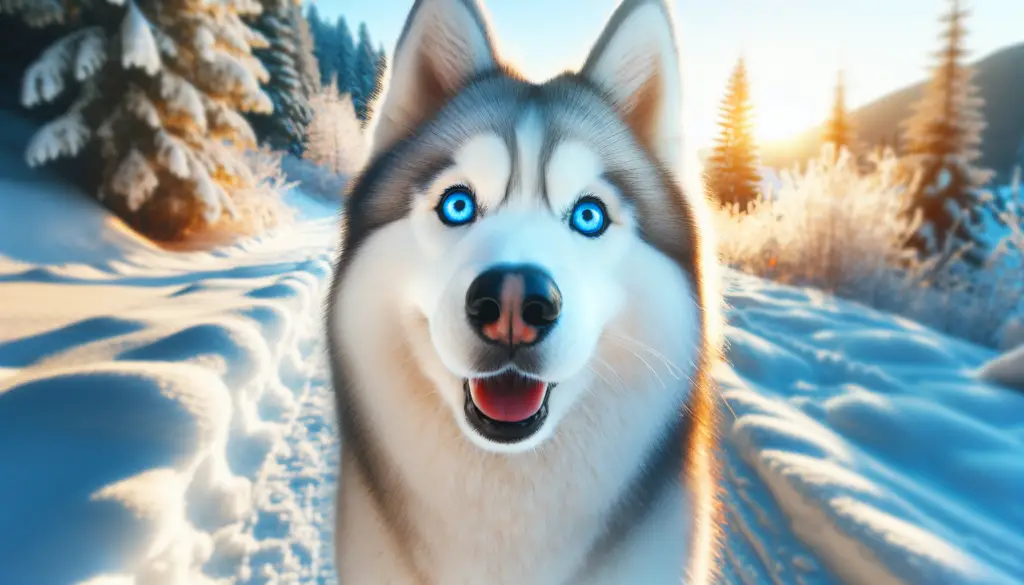Have you ever gazed into the icy stare of a Siberian husky? Those striking blue eyes are a defining characteristic, captivating and enigmatic. But what causes these enchanting ocular orbs to shine brighter than a cerulean summer sky on a Sunday afternoon picnic? Let’s unravel the mystery together, my fellow puppy enthusiasts.
Do you want to know more about the reasons why huskies have blue eyes? Then use the table of contents below to jump to the most relevant section. And you can always go back by clicking on the black arrow in the right bottom corner of the page. Also, please note that some of the links in this article may be affiliate links. For more details, check the Disclosure section at the bottom of the page.
Here's what we'll cover:
- What Makes Huskies’ Eye Color Unique?
- Genetics Behind Huskies’ Blue Eyes
- Factors That May Change Huskies’ Eye Color
- The Impact of Coat Color on Huskies’ Eye Color
- Understanding the Genetics of Blue-Eyed Huskies
- Common Misconceptions about Huskies’ Eye Color
- Potential Health Concerns Related to Blue Eyes in Huskies
- How to Care for Blue-Eyed Huskies?
- Final Thoughts
What Makes Huskies’ Eye Color Unique?
Among the canine world, this phenomenon of brilliant blue eyes is relatively rare, sporting the exclusivity level of a limited-edition handbag. Yet, we see a surplus of these gorgeous light blue eyes when it comes to our fluffy friend, the Siberian husky. According to research, many Siberian huskies have striking blue eyes, a feature far from universally matched among our other furry friends.
Genetics Behind Huskies’ Blue Eyes
Now, let’s delve into the world of genetics. My personal sojourn into dog DNA has unveiled fascinating insights into the cause of blue eyes in dogs, especially that of Siberian huskies. You see, a specific gene, known as ALX4 on chromosome 18, is predominantly responsible for their azure gaze. When these puppies are born with blue eyes, this isn’t some fluke or puppy magic; it’s all down to their unique genetic code.

Factors That May Change Huskies’ Eye Color
Now, let’s not get ahead of ourselves. Brown eyes aren’t a foreign concept to the husky clan. It’s quite possible for a husky to be born with blue eyes, only to have them turn brown as they mature — yet another plot twist from Nature herself!
The Impact of Coat Color on Huskies’ Eye Color
As we know, irresistible fur coats and Siberian huskies go hand in hand, much like marzipan on a Christmas cake. However, their resplendent fur goes beyond warming them against the cold Siberian weather. A bit of an intel from my breeder sources has revealed that the coat color may influence eye color too. A husky with a darker coat might likely possess rich blue or dark brown eyes. So, folks, the mystery is solved — this is how blue eyes are caused in our husky heroes! Now, I hope this knowledge has brought you closer to these noble companions, for there’s something quite special in understanding why huskies have striking blue eyes. It’s one of the delightful secrets Mother Nature has cherished within the world of husky dogs. After all, every dog carries a tale (and a tail!) that’s ready to wag its way into our hearts.
Common Eye Conditions in Huskies
As adorable as our sled-pulling, snow-loving pals are, Siberian Huskies aren’t without a few health quirks here and there. Particularly, their eyes. As dog owners, we’re always on the lookout for signs of discomfort or illness in our furry friends. And when it comes to Huskies, their striking blue, brown, or mismatched eyes require some extra attention. One common problem encountered in Huskies is heterochromia –a fascinating condition where one eye can be blue, and the other a completely different color. While it sure does make your Husky look different and quite unique, it’s a harmless condition requiring zero intervention. However, pay close attention to sudden changes that could indicate potential issues like loss of pigmentation or iris inflammation. When in doubt, always consult with your trusted veterinarian.
Understanding the Merle Gene and Blue Eyes in Huskies
Contrary to common belief, the Merle gene, usually associated with blue eyes in dogs like the Australian Shepherd, doesn’t play a prominent role in your Husky’s eye color. This fascinating gene is known to affect a dog’s coat and eye color, often resulting in dogs with one blue eye or distinctively spotted fur, like our Australian friends. However, its impact isn’t quite as pronounced in Huskies. Regardless, it’s always interesting to observe how genetics can influence our pups’ appearance in the most unexpected ways!
Understanding the Genetics of Blue-Eyed Huskies
The hypnotic blue eyes of a Husky aren’t just there by chance! It’s all thanks to genetics, my dog-loving friends. You can thank a gene mutation near the ALX4 gene on chromosome 18 for it. But don’t worry, in this case, mutate isn’t as scary as it sounds. It simply means that due to this change, less melanin (a pigment responsible for dark colors) is produced, resulting in those icy blue eyes that have charmed many dog owners around the world.
Exploring the Recessive Gene Responsible for Blue Eyes
Here’s a fun fact: The blue eyes in Huskies aren’t a dominant trait. That means, even if both parents have blue eyes, their Husky puppies’ eye color may still be a surprise. The fascinating genetic roulette that contributes to this includes the recessive gene. If the puppy inherits this gene from both parents, then voila, they might flaunt those famed blue peepers!
Genetic Traits and Eye Color in Husky Puppies
Remember when we talked about melanin? The pigment that lies within the iris of the eye? Well, this same pigment plays a huge role in determining the color of your Husky’s fur and, of course, those captivating eyes. At birth, most Husky puppies have blue eyes that can lighten or darken or even change color entirely as they grow older. Fascinating, isn’t it?
The Role of DNA and Genetics in Huskies’ Eye Color
If you’ve gathered nothing else from today’s puppy love science lesson, take this home: The stunning blue eyes or unique eye color patterns seen in Siberian Huskies boil down to their DNA and genetics. Isn’t science a hoot and a half? So the next time your Husky’s compelling gaze catches you off guard, remember the crazy cocktail of genes and DNA that give our cherished pooches their distinctive looks. Ain’t nature grand?
Comparing Blue Eyes in Huskies with Other Dog Breeds
Siberian Huskies have become popular in recent years, not just for their striking resemblance to wolves, but also for their distinct blue eyes. But have you ever wondered how it is that Huskies have these beautiful azure peepers, in comparison to other dog breeds? Well, the answer lies in pigmentation, or the lack thereof, and a specified genetic mutation known as ‘alx4’, located on chromosome 18. This mutation isn’t commonly found in many other breeds, with the exception of Border Collies and some Welsh Corgis.
The Connection between Blue Eyes and the Husky Breed
For Huskies, those enchanting blue eyes are a characteristic feature of the breed and totally independent of the merle gene that often leads to blue eyes in other breeds. The alx4 mutation on chromosome 18 plays a significant part in this attribute. In fact, according to research published by the American Kennel Club (AKC), the trait can even cause Huskies to have ‘parti-eyes’, or eyes that are half blue and half another color, typically brown or hazel.
Common Misconceptions about Huskies’ Eye Color
There are many misconceptions about Huskies and their eye color – primary among them is the belief that all Huskies have blue eyes. Not true! While many do, Siberian Huskies can also have brown, green, amber, and even parti-eyes.

Potential Health Concerns Related to Blue Eyes in Huskies
Are there potential health problems associated with the stunning blue eyes in Huskies? Well, blue eyes are often light-colored because they contain less melanin, the pigment that also leads to dark coats. This scarcity of pigment means that the colored part of the eye, the iris, doesn’t absorb as much light. Instead, it scatters the light, making the eyes appear blue. Therefore, Huskies with blue eyes might be more susceptible to damage caused by sun rays, so you should consult your vet for the best ways to protect your Husky’s eyes.
How to Care for Blue-Eyed Huskies?
When it comes to caring for your blue-eyed Husky, remember that, like humans, Huskies can also suffer from UV damage. Ensure you consult with your vet about any necessary precautions to protect those blue eyes when venturing outdoors.
Final Thoughts
Huskies are remarkable dogs with unique characteristics. Their blue or parti-eye color, caused by a genetic mutation and a lack of pigmentation, simply adds to their allure. As always, it’s essential to remember that these factors contribute to the breed’s beauty and should inspire responsible and appropriate care. Whether they are sparkling blue, earthy brown, or mystical parti-eyes, each Husky’s eyes tell a unique story, making them a beloved breed to so many dog enthusiasts around the world.
Thanks for the blog graphics: Canva.com
Doghint.com is a participant of several affiliate programs. The list includes (but not limited to) the following: VigLink, Refersion, ShareASale, and Amazon Services LLC Associates Program, an affiliate advertising program designed to provide a mean for us to earn fees by linking to Amazon.com and affiliated sites. Doghint.com does not intend to provide veterinary advice. All published articles are meant for informational purposes only and not substitute the professional veterinary consultation.


